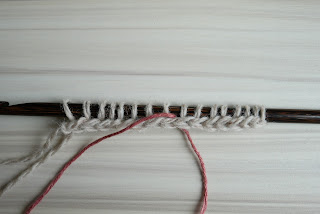I've done a little bit of Tunisian crochet (also called Afghan crochet), and in the couple of patterns for shaped garments that I've looked at I didn't see use of stitch markers. Likely this is because knit-type stitch markers, which are typically rings of some kind that you thread onto your needles, don't work in crochet. Tunisian crochet patterns seem to solve the lack of stitch markers by providing stitch counts. All well and good if you're working narrow pieces without increases or decreases, but once the piece is wider and maybe a bit more complicated? You spend a lot of time counting, losing track of the count, starting over counting, etc. Moreover, the written pattern can get very long and tough, or even tedious, to read.
Now, I don't do a lot of crochet, but I do like to make amigurumi animals from time to time, and from one pattern I learned about using scrap yarn to mark the beginning of each row. You can see example of using scrap yarn as a stitch marker here.
Stitches n Scraps does a fine job of explaining how to use scrap yarn for stitch markers, but I'm going to provide my own tutorial as applied more specifically to Tunisian crochet. I hope that Tunisian designers will adopt the use of stitch markers, and start writing more concise, easier to follow patterns.
Step 1:
I've cast on 16 stitches, and will use a marker to indicate the middle of this piece. I cut a piece of scrap yarn about 4" long. It's best to use a really smooth yarn, like cotton, and to stay away from a really grabby yarn, like wool.
Step 2:
Using a yarn needle or small crochet hook, pull the scrap yarn between the stitches where you want the marker to be.
You can also lay the scrap yarn in place when picking up the stitches, and I would if I'm casting on a lot of stitches and am using stitch markers to count them. I find picking up the first row a bit fiddly, though, so like to add the stitch marker after the stitches are on the hook.
Step 3:
Step 4:
Work the next forward pass (note that I'm doing Tunisian Knit Stitch (TKS) in this example). Once you've picked up the loop that is one stitch before the stitch marker, flip the scrap yarn over to the back of the work. Make sure your working yarn is on your left (or right, if you're working left-handed) to avoid the scrap yarn getting wrapped around the yarn in the back.
Finish the forward pass, work a reverse pass.
This is what the work looks like after the reverse pass.
Step 5:
Work the next forward pass. Once you've picked up the loop before the stitch marker, flip the end of the yarn from the back of the work to the front of the work. Again, make sure the working yarn is on the left before you flip the scrap yarn.
It's OK if the scrap yarn gets caught under the bit of yarn that sits between stitches, but the scrap yarn gets harder to pull out.
Complete the forward pass and work a reverse pass.
Continue flipping the scrap yarn from front to back or back to front on each forward pass (sometimes I flip the yarn only every other row).
After you've done a number of rows, you should have what looks like sewn stitches between two columns of the work.
I hope you will find these instructions helpful, and I encourage all Tunisian crochetters out there to use stitch markers everywhere and anywhere!











